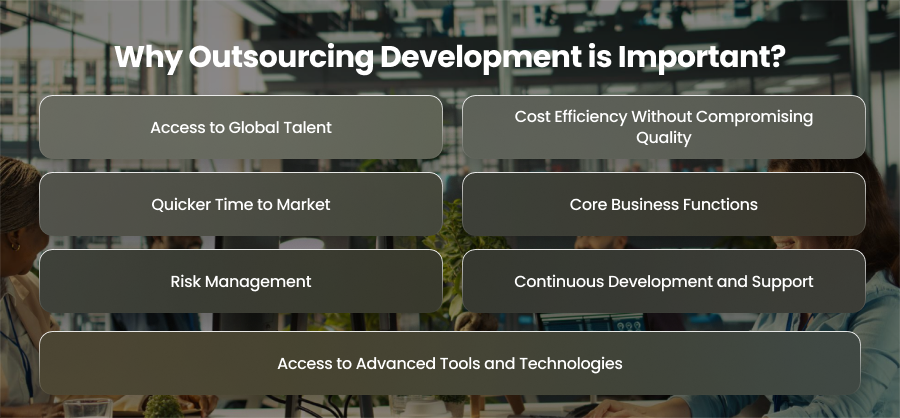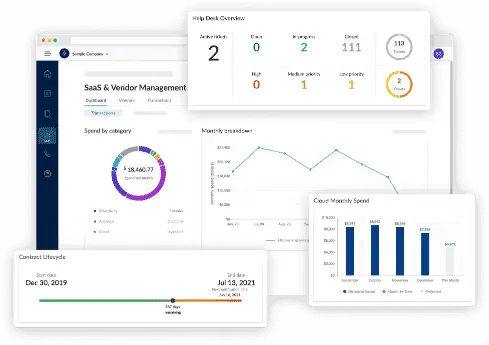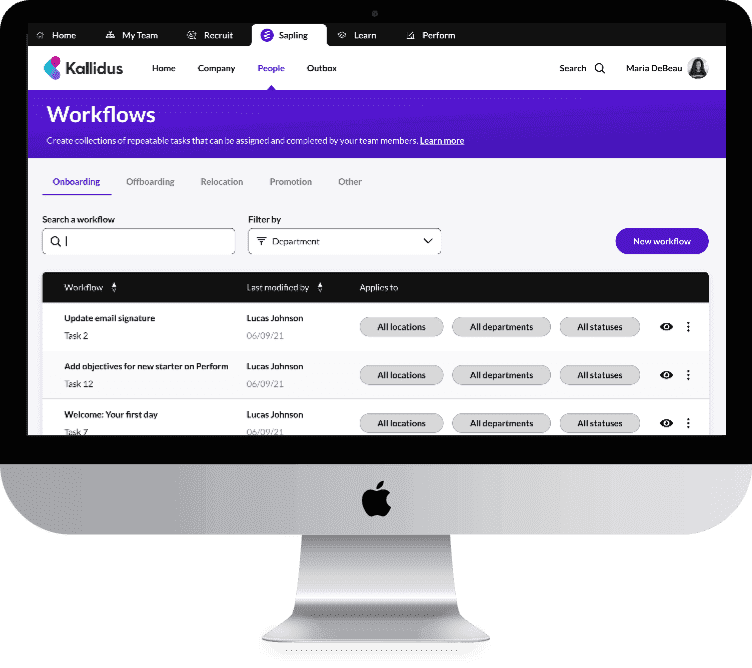KPMG reports that 60% of organizations are planning to assess their outsourcing strategies. Furthermore, the global business processing outsourcing market will reach $525 billion in just five years.
This is due to the fact that outsourcing software development allows businesses and startups to expand. It also provides companies with access to a global talent pool, which speeds up the production of goods. Outsourcing is not without its challenges, though.
We’ll examine the common mistakes businesses make while outsourcing software development in this blog.
Outsourcing Development
Outsourcing development is the process of hiring external individuals or teams to handle software development tasks that would otherwise be done in house. Moreover, this can include building a mobile app or managing a backend infrastructure. Also, outsourced developers can provide long term maintenance and support.
Additionally, using external developers is a calculated move meant to boost productivity and lessen the workload for in house teams.
Why Outsourcing Development is Important?

Access to Global Talent
The opportunity to access a worldwide talent pool is among the biggest justifications for outsourcing development. Furthermore, developers with specialized talents may be hired from anywhere in the world. As a result, this might broaden your choices and raise the possibility that you will locate qualified candidates for the position.
Cost Efficiency Without Compromising Quality
When you hire in house developers, it can be costly. Moreover, salaries and onboarding costs can add to the cost. Outsourcing offers a more flexible and budget friendly approach. Also, you can choose pricing models that align with your project goals.
Quicker Time to Market
One of the most precious resources in the IT industry is time. Therefore, if you want to be the first to market with a new product or provide a big improvement, outsourcing could help you cut down on time. An effective outsourcing partner may also swiftly deploy specialists and operate around the clock due to time zone variations. Delays and lengthy recruiting cycles may be avoided in this way.
Core Business Functions
Your internal teams can focus on their primary responsibilities, such as marketing and strategy planning, when you outsource your development work. Additionally, the leadership of your organization may focus on expansion and commercial development instead of being weighed down by technological difficulties.
Risk Management
Every development project carries a certain degree of risk, like technology failures to market shifts. Moreover, experienced outsourcing providers often have processes in place to mitigate these risks. They follow best practices in coding standards and version control. Hence, this can help minimize errors and setbacks.
Continuous Development and Support
A product’s launch is simply one aspect of outsourcing; another is its upkeep. Numerous businesses provide post launch assistance and continuing maintenance. This will allow you to keep your software secure without hiring a full-time maintenance crew.
Access to Advanced Tools and Technologies
It might be challenging for many companies to stay up to date with the latest technical developments. Outsourcing partners typically invest in infrastructure and equipment as part of their services. This implies that you can employ blockchain and artificial intelligence without having to deal with the expense and learning curve of hiring internal staff.
17 Mistakes Companies Make When Outsourcing Development

1. Choosing Cost Over Quality
By selecting the most economical outsourcing partner, many businesses want to save expenses. This isn’t a long-term answer, even if it could appear financially wise in the near term. Low rates often mean lower experience levels and poor code quality.
So, to avoid this, you should focus on value rather than cost. Additionally, you want to assess providers according to their experience and level of knowledge. You may also request a portfolio of their previous work. You should also check to see if they adhere to quality assurance protocols.
2. Lack of Clear Requirements
Incomplete or ambiguous project specifications might result in miscommunications and resource waste. Therefore, you should take the time to create a clear and comprehensive brief in order to prevent this. Moreover, you can include user stories and visual mockups. You can also include workflows and performance expectations, and any third party integrations.
3. Ignoring Time Zone Differences
Assuming your outsourcing partner would be accessible throughout your business hours without appropriate scheduling frequently results in annoying communication breakdowns and decision making delays.
Time zones should thus be taken into consideration when developing your cooperation strategy. To maintain a steady stream of communication, you should agree on overlapping working hours and make use of platforms like Slack and Trello.
4. Not Evaluating Technical Expertise
Some companies skip technical due diligence and hire development teams based on a few polished portfolio items. Hence, taking a vendor at their word without assessing their actual capabilities is a huge risk. Moreover, a lack of a proper vetting process often leads to developers who can write code but cannot make it maintainable or scalable.
Therefore, you should perform technical vetting and assign a trial task to assess the potential partner’s coding standards and problem solving skills. Moreover, this will help you assess their development practices. Furthermore, a skilled developer should also be able to recommend tools and best practices that enhance your project.
5. Poor Communication Practices
It’s a recipe for failure if you assume the development team will just figure out the solution to any problem without consistent communication. Outsourced teams need direction and feedback. Moreover, poor communication often leads to delays and misunderstood requirements. To avoid this, you should implement a structured communication process. This can include setting up weekly standups and ensuring someone from the business side is always available for clarification. This can empower them to take initiatives and suggest smarter solutions along the way.
6. No Project Ownership
Outsourced teams just provide what is requested of them and nothing more when they are not included in the decision making process. Uncertain duties and responsibilities are the cause of this lack of ownership. Hence, to foster ownership, you should give outsourced partners visibility into the bigger picture. Also, you can help them understand the business model and your user persona.
7. Skipping Legal Agreements
Some companies don’t offer legal agreements, which can cause issues later on. This can open the door for major legal and operations risks, especially with intellectual property. Moreover, without a clear contract, you can find yourself with missed deadlines and poorly defined ownership rights. Hence, a solid legal agreement should cover confidentiality and IP rights. Furthermore, the contract should include project scope and timelines, and payment schedules.
8. Overlooking Post Launch Support

Many companies think the job is done once the application goes live. However, bugs can appear, and users can give feedback. Moreover, updates can become necessary almost immediately. So, if you don’t discuss post launch support in advance, the team can become unavailable. Hence, you should include plans for maintenance and performance monitoring in the contract. This will ensure your product continues to perform and evolve even after the initial release.
9. Not Scaling the Team Properly
Some businesses try to push massive workloads onto a skeleton development team. They assume that the outsourcing partner will magically scale up as needed. Hence, this can result in bottlenecks and missed deadlines. Also, over hiring too soon can drain budgets.
So, scaling needs to be strategic. You can start with a core staff and expand as needed, depending on the project’s workload and stage. Furthermore, a capable outsourcing partner may offer you guidance on when and how to add more engineers or DevOps specialists without exceeding your spending limit or timeline.
10. Failing to Build a Long Term Relationship
Outsourcing isn’t just a small term solution; it can also be a long term strategic advantage. Some companies treat outsourcing partners as disposable resources, which can result in high turnover and a lack of continuity. Each new team needs to understand your business and technologies.
So, instead of building new teams, you should aim to build a long term partnership where the outsourcing partner becomes an extension of your team. You should invest in the relationship and involve them in roadmap planning.
11. Underestimating Cultural Differences
Although they are sometimes disregarded, cultural differences may have a big influence on how a team communicates and responds to criticism. One culture may view something as direct communication while another may view it as impolite. In a similar vein, there are wide variations in the sense of urgency and how deadlines are approached. These gaps can cause misinterpretations or tensions if not acknowledged. To avoid such issues, companies should foster cross cultural awareness.
12. Not Involving In House Teams
One major mistake is failing to integrate outsourced developers with in house teams. When external partners operate in isolation, they fail to develop features or workflows that don’t align with the broader architecture or vision. So, this siloed approach leads to inefficiencies and integration nightmares. Hence, the solution is collaboration. You should include your internal team in planning and feedback cycles. You can hold joint stand ups and use shared repositories. Furthermore, you should maintain a single source of truth for documentation.
13. Neglecting Security and Compliance
Outsourcing doesn’t exempt a company from its responsibility to ensure data protection and regulatory compliance. In fact, handing off development to an external team increases the risk surface. When companies fail to enforce strong cybersecurity standards, they expose themselves to potential breaches.
So, establish rigorous security protocols from the start. Ensure outsourced partners follow best practices like encryption and secure access control. Moreover, if your industry requires compliance with laws, then ensure that the vendor understands and agrees to follow those standards.
14. Inadequate Project Management
You can derail your project quickly if you assume that an outsourced team will manage itself. So, without a defined leadership, there’s no one to track progress or resolve roadblocks. As a result, tasks can fall through the cracks, and the final product can lack polish. Every outsourced project needs a dedicated project manager. This role ensures structured workflows and milestone based delivery.
15. Failing to Measure Performance
You can’t improve what you don’t measure. Many companies fail to track key performance indicators during projects. This can make identifying areas of inefficiency or areas of concern difficult. Hence, you should set performance metrics such as sprint velocity and code quality scores. Furthermore, you should measure response time to bugs. Moreover, you can use tools like Jira to log tasks and track progress. Also, you can conduct regular reviews and retrospectives to ensure continuous improvement.
16. Disregarding Code Ownership and Access Control

Companies sometimes forget to clarify who owns the code and intellectual property. Hence, this becomes a problem if the relationship ends abruptly or if the outsourcing partner restricts access to their repositories or cloud environments. You can avoid this by explicitly stating in contracts that your company owns all source code and assets.
17. Ignoring the Importance of Onboarding
Outsourced developers need proper onboarding just like internal hires. Companies often skip this step. Hence, without context on the business and architecture, even the most talented developers will struggle. You should provide a comprehensive onboarding process with documentation and business context.
Final Words
Proactive risk management and strategic planning are necessary for outsourcing. By putting quality above cost and encouraging cooperation, businesses may also steer clear of these typical outsourcing problems. So, by using these best practices to build productive and reliable long term partnerships.



















